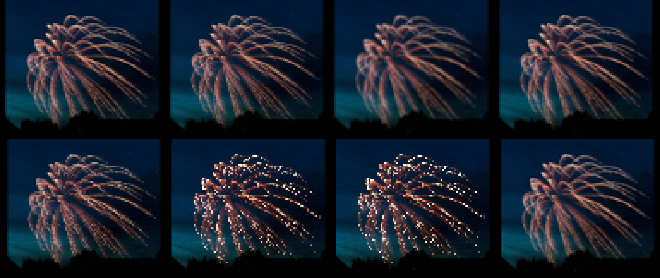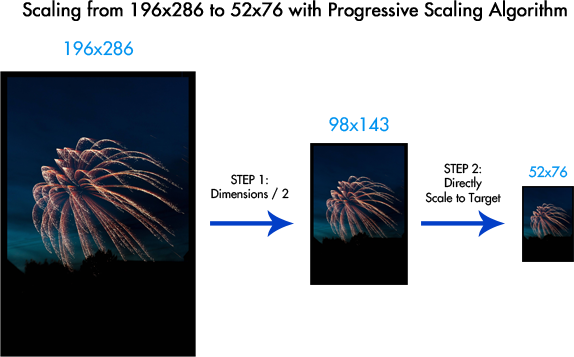Q: Java - resize image without losing quality
Table of Contents
Unfortunately, there is no recommended out-of-the-box scaling in Java that provides visually good results. Among others, here are the methods I recommend for scaling:
- Lanczos3 Resampling (usually visually better, but slower)
- Progressive Down Scaling (usually visually fine, can be quite fast)
- One-Step scaling for up scaling (with
Graphics2dbicubic fast and good results, usually not as good as Lanczos3)
Examples for every method can be found in this answer.
Visual Comparison #
Here is your image scaled to 96x140 with different methods/libs. Click on the image to get the full size:
- Morten Nobel’s lib Lanczos3
- Thumbnailator Bilinear Progressive Scaling
- Imgscalr ULTRA_QUALTY (1/7 step Bicubic Progressive Scaling)
- Imgscalr QUALTY (1/2 step Bicubic Progressive Scaling)
- Morten Nobel’s lib Bilinear Progressive Scaling
Graphics2dBicubic interpolationGraphics2dNearest Neighbor interpolation- Photoshop CS5 bicubic as reference
Unfortunately a single image is not enough to judge a scaling algorithm, you should test icons with sharp edges, photos with text, etc.
Lanczos Resampling #
Is said to be good for up- and especially downscaling. Unfortunately there is no native implementation in current JDK so you either implement it yourself and use a lib like Morten Nobel’s lib. A simple example using said lib:
ResampleOp resizeOp = new ResampleOp(dWidth, dHeight);
resizeOp.setFilter(ResampleFilters.getLanczos3Filter());
BufferedImage scaledImage = resizeOp.filter(imageToScale, null);
The lib is published on maven-central which is not mentioned, unfortunately. The downside is that it usually is very slow without any highly optimized or hardware accelerated implementations known to me. Nobel’s implementation is about 8 times slower than a 1/2 step progressive scaling algorithm with Graphics2d. Read more about this lib on his blog.
Progressive Scaling #
Mentioned in Chris Campbell’s blog about scaling in Java, progressive scaling is basically incrementally scaling an image in smaller steps until the final dimensions are reached. Campbell describes it as halving width/height until you reach target. This produces good results and can be used with Graphics2D which can be hardware accelerated, therefore usually having very good performance with acceptable results in most cases. The major downside of this is if downscaled less than half using Graphics2D provides the same mediocre results since it is only scaled once.
Here is a simple example on how it works:
The following libs incorporate forms of progressive scaling based on Graphics2d:
Thumbnailator v0.4.8 #
Uses the progressive bilinear algorithm if the target is at least half of every dimension, otherwise it uses simple Graphics2d bilinear scaling and bicubic for upscaling.
Resizer resizer = DefaultResizerFactory.getInstance().getResizer(
new Dimension(imageToScale.getWidth(), imageToScale.getHeight()),
new Dimension(dWidth, dHeight))
BufferedImage scaledImage = new FixedSizeThumbnailMaker(
dWidth, dHeight, false, true).resizer(resizer).make(imageToScale);
It is as fast or slightly faster than one-step scaling with Graphics2d scoring an average of 6.9 sec in my benchmark.
Imgscalr v4.2 #
Uses progressive bicubic scaling. In the QUALITY setting it uses Campbell style algorithm with halving the dimensions every step while the ULTRA_QUALITY has finer steps, reducing the size every increment by 1/7 which generates generally softer images but minimizes the instances where only 1 iteration is used.
BufferedImage scaledImage = Scalr.resize(imageToScale, Scalr.Method.ULTRA_QUALITY, Scalr.Mode.FIT_EXACT, dWidth, dHeight, bufferedImageOpArray);
The major downside is performance. ULTRA_QUALITY is considerably slower than the other libs. Even QUALITY a bit slower than Thumbnailator’s implementation. My simple benchmark resulted in 26.2 sec and 11.1 sec average respectively.
Morten Nobel’s lib v0.8.6 #
Has also implementations for progressive scaling for all basic Graphics2d (bilinear, bicubic & nearest neighbor)
BufferedImage scaledImage = new MultiStepRescaleOp(dWidth, dHeight, RenderingHints.VALUE_INTERPOLATION_BILINEAR).filter(imageToScale, null);
A word on JDK Scaling Methods #
Current jdk way to scale an image would be something like this
scaledImage = new BufferedImage(dWidth, dHeight, imageType);
Graphics2D graphics2D = scaledImage.createGraphics();
graphics2D.setRenderingHint(RenderingHints.KEY_INTERPOLATION, RenderingHints.VALUE_INTERPOLATION_BILINEAR);
graphics2D.drawImage(imageToScale, 0, 0, dWidth, dHeight, null);
graphics2D.dispose();
but most are very disappointed with the result of downscaling no matter what interpolation or other RenderHints are used. On the other hand upscaling seems to produce acceptable images (best would be bicubic). In previous JDK version (we’re talking 90s v1.1) Image.getScaledInstance() was introduced which provided good visual results with parameter SCALE_AREA_AVERAGING but you are discouraged to use it - read the full explanation here.


